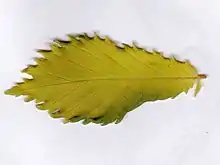Ulmus minor 'Viminalis Aurea'
The Field Elm cultivar Ulmus minor 'Viminalis Aurea', probably a "golden" form of Ulmus minor 'Viminalis',[1] was raised before 1866 by Egide Rosseels of Louvain,[2] who was known to have supplied 'Viminalis'.[3]
| Ulmus minor 'Viminalis Aurea' | |
|---|---|
 | |
| Species | Ulmus minor |
| Cultivar | 'Viminalis Aurea' |
| Origin | Louvain, Belgium |
Description
The tree is distinguished by its 'Viminalis'-type leaves (4–7 cm x 3 cm) suffused golden yellow in early summer, greening as the season progresses.[4][5][6] Clibran's of Altrincham (see 'Cultivation') described the coloration as "golden-bronze".[7] Rehder noted that 'Viminalis Aurea' has been distinguished from 'Viminalis' by the more deeply incised usually obvate leaves, but the two forms of leaves pass gradually into each other and may be found even on the same plant.[8]
 Illustration of 'Aurea', 1866
Illustration of 'Aurea', 1866 'Aurea' at Borde Hill, West Sussex, 2010.
'Aurea' at Borde Hill, West Sussex, 2010.
Pests and diseases
'Viminalis Aurea' is very susceptible to Dutch elm disease.
Cultivation
One tree supplied by the Späth nursery of Berlin was planted in 1899 at the Dominion Arboretum, Ottawa, Canada, as U. campestris antarctica aurea.[9] Three specimens were supplied by Späth to the Royal Botanic Garden Edinburgh in 1902 as U. antarctica aurea, and may survive in Edinburgh as it was the practice of the Garden to distribute trees about the city (viz. the Wentworth Elm).[10] The current list of Living Accessions held in the Garden per se does not list the plant. In England the tree was supplied by Clibrans' nursery of Altrincham, Cheshire, as Ulmus campestris aurea Rosseelsii.[11][7] Only two specimens are known (2016) to survive in the UK, a stunted tree at Borde Hill, West Sussex.[12] and a small tree (2016) at Grange Farm Arboretum (see Accessions). Others are known in Europe and Australasia[13] (see Accessions).
Synonymy
- Ulmus antarctica aurea: Späth nursery[14][15]
- Ulmus campestris var. antarctica aurea: Nicholson, Kew Hand List Trees & Shrubs, ii, 613, 1902.
- Ulmus campestris var. aurea: Morren: La Belgique horticole, p. 356, 1866, (coloured plate), and Lemaire: L'Illustration horticole t 513, 1867.
- Ulmus campestris var. Rosscelsii: Schelle, in Beissner et al., Handbuch der Laubholz-Benennung 83. 1903, = misspelling of Rosseelsii.
- Ulmus rosseelsii: Koch, Dendrologie; Bäume, Sträucher und Halbsträucher, welche in Mittel- und Nord- Europa im Freien kultivirt werden 2 (1): 412, 1872, in synonymy.
Accessions
- North America
None known.
- Europe
- Borde Hill Garden, Haywards Heath, UK. Acc. no. 47334 (As Ulmus minor 'Viminalis Aurea').[16]
- Grange Farm Arboretum, Sutton St James, Spalding, Lincolnshire, UK. Acc. no. 1102.
- University of Copenhagen Botanic Garden, Denmark. As Ulmus procera 'Viminalis Aurea'.
- Australasia
- Waite Arboretum , University of Adelaide, Adelaide, Australia[17]
Nurseries
- North America
- Europe
- Arboretum Waasland , Nieuwkerken-Waas, Belgium.
- Czeczot Krzewy , Bogumiłowice, Poland.
- Szkółka Krzewów Ozdobnych , Bielsko-Biała, Poland.
- Szkółki Konieczko , Gogolin, Poland.
References
- Bean, William Jackson (1988). Trees and shrubs hardy in Great Britain (8th ed.). London: Murray. p. 659.
- Green, Peter Shaw (1964). "Registration of cultivar names in Ulmus". Arnoldia. Arnold Arboretum, Harvard University. 24 (6–8): 41–80. Retrieved 16 February 2017.
- Witte, H. (1865). Algemeene tentoonstelling van voortbrengselen van tuinbouw te Amsterdam (in Dutch). 1. Retrieved 10 July 2017.
- Hilliers' Manual of Trees & Shrubs. (1977). David & Charles, Newton Abbot, UK.
- Bean, W. J. (1980) Trees and shrubs hardy in Great Britain. 8th edition. Murray's, London.
- Krüssman, Gerd, Manual of Cultivated Broad-Leaved Trees & Shrubs (1984 vol. 3)
- Clibrans Ltd. (1921). Ornamental Trees Shrubs & Climbers. Season: 1921-22. Altrincham, Cheshire, UK: Clibrans. p. 15.
- Rehder, Alfred (1919). "Rehder, new species, varieties and combinations". Journal of the Arnold Arboretum. 1: 140–141. Retrieved 10 July 2017.
- Catalogue of the trees and shrubs in the arboretum and botanic gardens at the central experimental farm (2nd ed.). 1899. p. 74.
- Accessions book. Royal Botanic Garden Edinburgh. 1902. pp. 45, 47.
- Clibrans Ltd., Ornamental Trees Shrubs & Climbers, cat. 269, Altrincham, 1908-09, p.27
- Johnson, O. (ed.). (2011). Champion Trees of Britain & Ireland. p. 171. Royal Botanic Gardens, Kew, London. ISBN 978-1842464526
- 'Viminalis Aurea' in the Waite Arboretum, trusttrees.org.au
- Katalog (PDF). 108. Berlin, Germany: L. Späth Baumschulenweg. 1902–1903. pp. 132–133.
- Späth, Ludwig (1930). Späth-Buch, 1720-1930. Berlin: Self published. pp. 311–313, 351–352
- "Champion Trees - Borde Hill Garden". Borde Hill Garden. Retrieved 2017-07-09.
- Spencer, R.; Hawker, J. & Lumley, P. (1991). Elms in Australia. Australia: Royal Botanic Gardens, Melbourne. ISBN 0-7241-9962-4.
External links
- "Herbarium specimen - L.1581935". Botany catalogues. Naturalis Biodiversity Center. Sheet described as U. procera Rosseelsii (Den Haag specimen, 1931)
- "Herbarium specimen - L.1581948". Botany catalogues. Naturalis Biodiversity Center. Sheet labelled U. viminalis aurea (Hillier, Winchester, 1952)